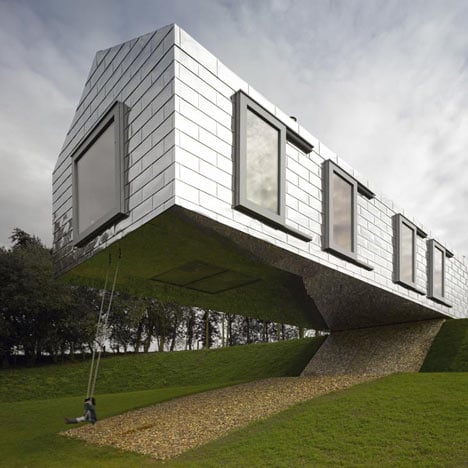Here are some photographs by Edmund Sumner of the completed Balancing Barn holiday home in Suffolk, UK, by MVRDV and Mole Architects, including a swing under the 15 metre cantilever.
The project is the first of five in Alain de Botton’s Living Architecture project and available for rent from 22 October.
The building is clad in reflective panels and the interior was created by Dutch designers Studio Makkink & Bey.
More about the project here.
Photographs are by Edmund Sumner.
The information below is from MVRDV:
Balancing Barn, a cantilevered holiday home near the village of Thorington in Suffolk, England, was completed last Tuesday. The Barn is 30 meters long, with a 15 meters cantilever over a slope, plunging the house headlong into nature. Living Architecture, an organization devoted to the experience of modern architecture, commissioned MVRDV in 2008. Mole Architects from Cambridge were executive architects and Studio Makkink & Bey from Amsterdam collaborated on the interior. The Barn is now available for holiday rentals.
Balancing Barn is situated on a beautiful site by a small lake in the English countryside near Thorington in Suffolk. The Barn responds through its architecture and engineering to the site condition and natural setting. The traditional barn shape and reflective metal sheeting take their references from the local building vernacular. In this sense the Balancing Barn aims to live up to its educational goal in re-evaluating the countryside and making modern architecture accessible. Additionally, it is both a restful and exciting holiday home. Furnished to a high standard of comfort and elegance, set in a quintessentially English landscape, it engages its temporary inhabitants in an experience.
Approaching along the 300 meter driveway, Balancing Barn looks like a small, two-person house. It is only when visitors reach the end of the track that they suddenly experience the full length of the volume and the cantilever. The Barn is 30 meters long, with a 15 meters cantilever over a slope, plunging the house headlong into nature. The reason for this spectacular setting is the linear experience of nature. As the site slopes, and the landscape with it, the visitor experiences nature first at ground level and ultimately at tree height. The linear structure provides the stage for a changing outdoor experience.
At the midpoint the Barn starts to cantilever over the descending slope, a balancing act made possible by the rigid structure of the building, resulting in 50% of the barn being in free space. The structure balances on a central concrete core, with the section that sits on the ground constructed from heavier materials than the cantilevered section. The long sides of the structure are well concealed by trees, offering privacy inside and around the Barn.
Click above for larger image
The exterior is covered in reflective metal sheeting, which, like the pitched roof, takes its references from the local building vernacular and reflects the surrounding nature and changing seasons.
Click above for larger image
On entering the Barn, one steps into a kitchen and a large dining room. A series of four double bedrooms follows, each with separate bathroom and toilet. In the very centre of the barn the bedroom sequence is interrupted by a hidden staircase providing access to the garden beneath. In the far, cantilevered end of the barn, there is a large living space with windows in three of its walls, floor and ceiling.
Click above for larger image
The addition of a fireplace makes it possible to experience all four elements on a rainy day. Full height sliding windows and roof lights throughout the house ensure continuous views of, access to and connectivity with nature.
Click above for larger image
The interior is based on two main objectives:
- The house is an archetypical two-person home, expanded in shape and content so that it can equally comfortably accommodate eight. Two will not feel lost in the space, and a group of eight will not feel too cramped.
- A neutral, timeless timber is the backdrop for the interior, in which Studio Makkink & Bey have created a range of furnishings that reflect the design concept of the Barn.
Click above for larger image
The rooms are themed. Partly pixilated and enlarged cloud studies by John Constable and country scenes by Thomas Gainsborough are used as connecting elements between the past and contemporary Britain, as carpets, wall papers and mounted textile wall-elements.
Click above for larger image
The crockery is made up of a set of English classics for two, and a modern series for a further six guests, making an endless series of combinations possible and adding the character of a private residence to the home.
Click above for larger image
The Barn is highly insulated, ventilated by a heat recovery system, warmed by a ground source heat pump, resulting in a high energy efficient building.
See also:
.
| More about this project |
Even more about this project |
More about Living Architecture |

